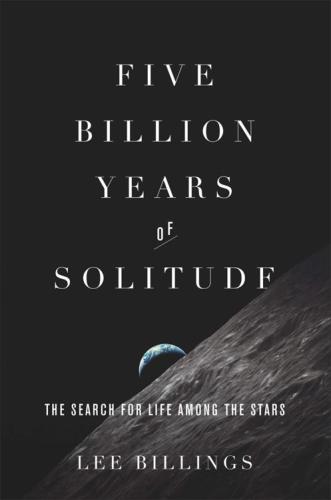
Five Billion Years of Solitude
The Search for Life Among the Stars
کتاب های مرتبط
- اطلاعات
- نقد و بررسی
- دیدگاه کاربران
نقد و بررسی

August 12, 2013
In his efforts to put a human face on the grand hunt for "life among the stars"âor at least a planet where life could existâscience writer Billings loses sight of the search and gets caught up in historical asides, profiles of scientists, and distracting poetic musings. His approach is novel, but all too often the results resemble just thatâthat is, a novel: Billings relies on interviews with researchersâincluding Frank Drake of the SETI ("search for extraterrestrial intelligence") Institute, MIT's Sara Seager, and the preeminent discoverer of extrasolar planets, UC Berkley's Geoff Marcyâconducted in relaxed settings: a home in Santa Cruz, a Pennsylvania farm, a family evening in Concord, Mass. Wherever his interviewees skim the surface, Billings fills readers in on the science behind the story. If he had stuck to this format, the book might havewould've worked. Instead, he muddles the narrative with chapters on, for example, the history of astronomy in the Western world and the early epochs of Earth; these topics have been covered better elsewhere. And in his section on Seager, Billings dwells longer on the tragic death of her husband than on her work. The individual pieces are interesting, but they fail to cohere. Agent: Peter Tallack, Science Factory (U.K.).

August 15, 2013
Science writer Billings debuts with this examination of the Search for Extra-Terrestrial Intelligence and the surprising perspective it provides in thinking about mankind and the deep-time history of Earth. The author bases his work on interviews and discussions with leaders from successive generations of the quest to find extraplanetary life. Frank Drake, who was an organizer of the original 1961 conference that set parameters for the project, concluded that "the universe, on balance, was a rather hospitable place, one that surely must be overflowing with living worlds." Among the participants was Carl Sagan, who would go on to popularize the search through his PBS show Cosmos. In 1989 and 1990, Sagan showed that the technological methods then employed could discriminate the Earth from the moon using the scanning devices on NASA probes. Billings' interlocutors include, among others, Greg Laughlin, who worked on "the wealth of Neptune-mass planets" revealed by NASA's Kepler project, and James Kasting, who developed models that could assist in the extrapolation of information about the composition of exoplanets, planetlike objects orbiting distant stars, from data received. These scientists have extended technology's frontiers and enabled motion at a scale of 1 meter per second on the surface of a star many light years away to be detected and analyzed. Now, exoplanets can be cataloged in the thousands, their compositions analyzed. Billings' accounts of arguments about inferences drawn, and even the existence of objects apparently observed, are fascinating. Kasting and Laughlin both provide insight on the geological and biological history of Earth, as well as current thinking about how life, and intelligence, may have developed. Billings documents how arbitrary changes in political priorities and funding reductions have wreaked havoc with the research. A great outline of the subject, bringing what's often treated as science fiction down to Earth, where it can be understood.
COPYRIGHT(2013) Kirkus Reviews, ALL RIGHTS RESERVED.

October 1, 2013
Billings (contributor, Nature; Popular Mechanics, etc.) interviewed astronomers and geologists to compile this occasionally meandering overview of the still-evolving field of "exoplanetary" research (discovery and characterization of planets orbiting other stars). Early dreams that we would locate and visit intelligent, technologically sophisticated beings elsewhere in space have been tempered as declining governmental funding has restricted our planet hunting. Today's astronomers are still intrigued by the possibility of discovering ever more exoplanets and by primitive nonterrestrial life forms but are far less optimistic about finding intelligent life or sending manned spacecraft outside the solar system. While this book may dampen the dreams of young planet hunters and exobiologists, the scientists featured still offer the hope that a combination of commercially viable unmanned spaceflight, public outreach by astronomers, and effective lobbying for improved research funding could expand our capacities to find new, somehow inhabited worlds beyond our own. VERDICT Complementary to Michael D. Lemonick's more optimistic Mirror Earth: The Search for Our Planet's Twin and less technical than Ray Jayawardhana's Strange New Worlds: The Search for Alien Planets and Life Beyond Our Solar System, this work will appeal to amateur astronomers and geologists as well as to general science buffs.--Nancy Curtis, Univ. of Maine Lib., Orono
Copyright 2013 Library Journal, LLC Used with permission.

October 1, 2013
When scientists first began an ambitious search for extraterrestrial radio signals in the early 1960s, the space race was in full swing and government funding for NASA's pet projects was enthusiastically openhanded. Today, the formerly heralded project known as SETI garners a fraction of its once sizable budget, and instead, astronomers are spending more time peering outside our solar system to pinpoint distant worlds dubbed exoplanets. Lately, barely a month passes without the media announcing a new discovery. Exoplanet detection is space science's hottest field, one which science writer Billings surveys here with exceptional clarity while peering over the shoulders of the planet hunters' leading pioneers. Along with an absorbing history of celestial-body sightings from the Greeks to Galileo, Billings profiles colorful contemporary researchers, such as astrophysicist Greg Laughlin, who assesses planets' values based on their available resources (Earth's weigh in at $5 quadrillion), and astronomer Matt Mountain, who has been lobbying Washington for a billion-dollar space telescope. A fascinating and informative read for both casual and serious astronomy buffs.(Reprinted with permission of Booklist, copyright 2013, American Library Association.)

























دیدگاه کاربران